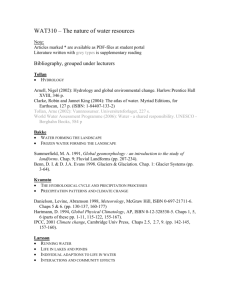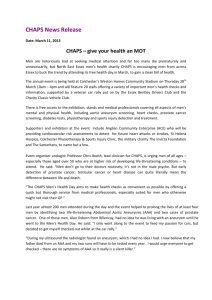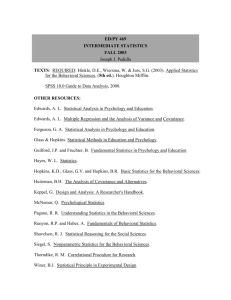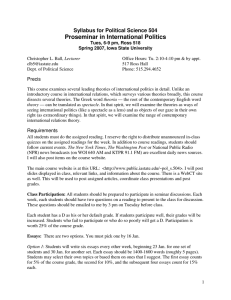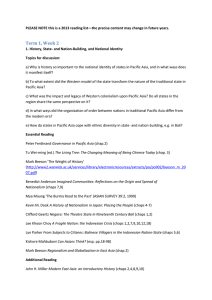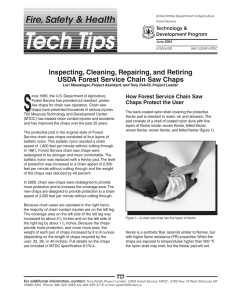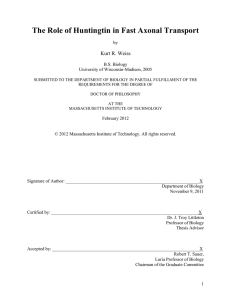High Tech Trash ENVS 295, University of Vermont, Spring 2007 Dr.
advertisement
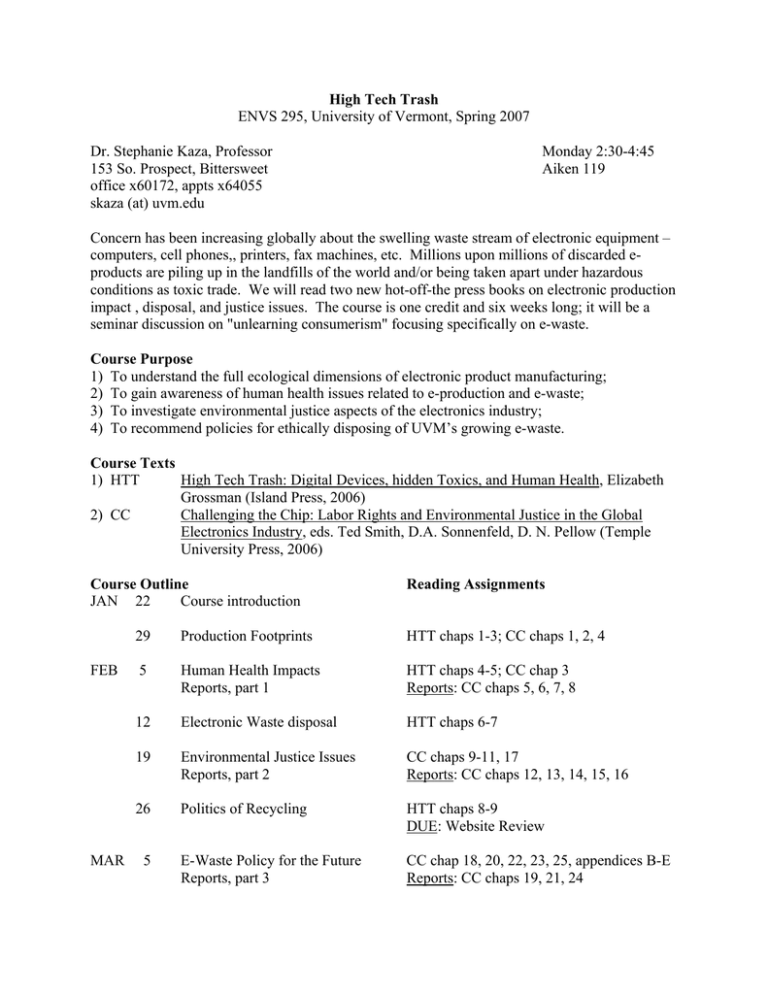
High Tech Trash ENVS 295, University of Vermont, Spring 2007 Dr. Stephanie Kaza, Professor 153 So. Prospect, Bittersweet office x60172, appts x64055 skaza (at) uvm.edu Monday 2:30-4:45 Aiken 119 Concern has been increasing globally about the swelling waste stream of electronic equipment – computers, cell phones,, printers, fax machines, etc. Millions upon millions of discarded eproducts are piling up in the landfills of the world and/or being taken apart under hazardous conditions as toxic trade. We will read two new hot-off-the press books on electronic production impact , disposal, and justice issues. The course is one credit and six weeks long; it will be a seminar discussion on "unlearning consumerism" focusing specifically on e-waste. Course Purpose 1) To understand the full ecological dimensions of electronic product manufacturing; 2) To gain awareness of human health issues related to e-production and e-waste; 3) To investigate environmental justice aspects of the electronics industry; 4) To recommend policies for ethically disposing of UVM’s growing e-waste. Course Texts 1) HTT High Tech Trash: Digital Devices, hidden Toxics, and Human Health, Elizabeth Grossman (Island Press, 2006) 2) CC Challenging the Chip: Labor Rights and Environmental Justice in the Global Electronics Industry, eds. Ted Smith, D.A. Sonnenfeld, D. N. Pellow (Temple University Press, 2006) Course Outline JAN 22 Course introduction FEB MAR Reading Assignments 29 Production Footprints HTT chaps 1-3; CC chaps 1, 2, 4 5 Human Health Impacts Reports, part 1 HTT chaps 4-5; CC chap 3 Reports: CC chaps 5, 6, 7, 8 12 Electronic Waste disposal HTT chaps 6-7 19 Environmental Justice Issues Reports, part 2 CC chaps 9-11, 17 Reports: CC chaps 12, 13, 14, 15, 16 26 Politics of Recycling HTT chaps 8-9 DUE: Website Review E-Waste Policy for the Future Reports, part 3 CC chap 18, 20, 22, 23, 25, appendices B-E Reports: CC chaps 19, 21, 24 5 Writing Assignments 1) Chapter Report (60%) – Each person will sign up to teach/report on one of the in-depth case study chapters of Challenging the Chip. You should bring to class a one-page single-spaced summary of the key points in the chapter to accompany your oral presentation. On the back of the page, provide three lists: a) 3-4 key ethical questions/issues raised by the material in the chapter, b) two springboard discussion questions, and c) 4-6 key references (literature or web) cited or relevant to the chapter. Bring enough copies of your report to class for everyone. You will have approximately 10 minutes for your teach-in, so prepare it carefully and use your time well. Teaching aids can be helpful if appropriate (maps, charts, diagrams). 2) Website Review (20%) – Choose one website from each of the lists provided in class (drawn from HTT 270-272 and CC 337-338) for a total of two websites to investigate. I will compile these notes into an annotated list for the entire class. For each site, review all of the menu subject areas to explore the site in depth. Then summarize your findings in bullet point style: • • • • • main purpose of organization re: e-waste category – nonprofit, business, government agency current news stories on e-waste innovative programs usefulness of site as a resource Note: Keep your review to 12 lines maximum per site, 11 pt Times, margins 1”, single space. Course Grading The two assignments cover 80% of the course grade; the remaining 20% will reflect the caliber of your discussion contributions in class. These will be a measure of how thoroughly you have done the reading and thought about the issues raised. Chapter Report 60 pts (40 pts written report, 20 pts oral teach-in) Website Review 20 pts Discussion 20 pts Total 100 pts Course Policies Absences -- Attendance will be taken, and unexcused absences will factor into your final grade. Absences are not “excused” unless they are personally cleared with me by phone or email. I expect you to make it a commitment to attend every class, particularly because it is such a short course and missing any one day is missing 17% of the course. Plagiarism -- I support UVM’s commitment to academic honesty. This means your written words should be your own. If you draw on other sources, they should be cited properly to give adequate credit. Work that appears to be plagiarized will be given no credit and students will be asked to meet with the instructor to explain the situation. Plagiarism at UVM is grounds for academic suspension; don’t do it.
